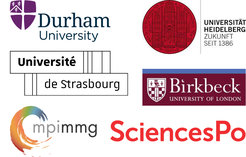
The multi-disciplinary team uses a variety of complementary research methods to examine a multiplicity of perspectives on our research questions concerning Jewish-Muslim encounter, diversity and distance. The research is predominantly qualitative and fieldwork-based in France, Germany and the UK. It is grounded in two city-regions in each country, with diverse populations, including significant Jewish and Muslim minorities. These are: Paris (greater Paris) /Strasbourg (grand Est), London (greater London)/Manchester (greater Manchester), Berlin (Länder Berlin)/Frankfurt (Länder Hesse). We are undertaking the following: ethnographic observations/participant observation (in selected sites such as neighbourhoods, streets or places and local events); guided and semi-structured interviews (virtual and in-person); key informant and expert interviews; group interviews/focus groups; policy analysis ; the ethnography of walking (mobile interviews with informants as they go about their everyday business); historical and archival desktop and library-based cultural and political context research; a telephone survey.

The methodology will mix qualitative and quantitative approaches of the sites, combining intensive participative observation in areas of potential Muslim-Jewish encounter with survey-based research on attitudes and discourse analysis of community media both written (magazines, blogs, websites) and spoken (YouTube). These methods allow us to understand better how both top-down institutionalized encounter and bottom-up/organic (or serendipitous) everyday encounters act on representations of Jewish-Muslim relations. This ties into the broader question of the impact local, ultra-local and national frames have on representation and action. The research team is interdisciplinary, including sociologists, anthropologists, political scientists, historians and media researchers. The field researchers are post-doctoral scholars grounded in anthropology, ethnomusicology, sociology and history: their training, research experience and enthusiasim alongside the extensive track records of the senior scholars leading each of the city sites and the works packages on attitudes, governance and media reflect the methods chosen for the project.
